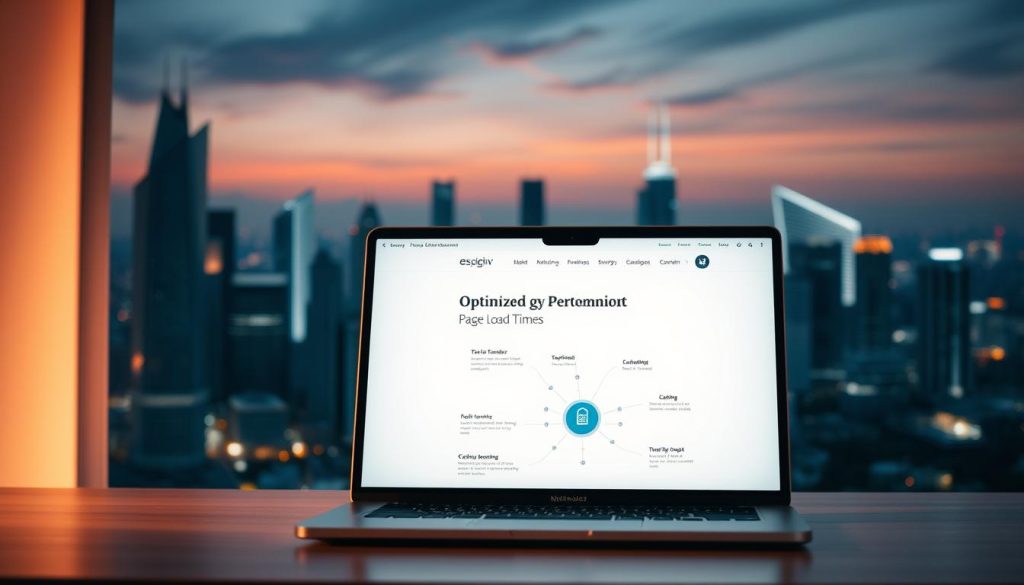Are you struggling to get your website noticed online? With millions of websites competing for attention, it’s easy to get lost in the noise.
Is your website optimized for search engines? A well-optimized website is crucial for improving your online visibility and driving more traffic to your site.
By following SEO best practices, you can significantly enhance your website’s ranking on search engine results pages. This, in turn, can lead to more leads, sales, and revenue for your business.
Key Takeaways
Table of Contents
- Understand the importance of having an on-page SEO checklist
- Learn how to optimize your website according to the latest SEO best practices
- Discover the essential steps to improve your website’s visibility
- Enhance your online presence with a well-optimized website
- Drive more traffic to your site with effective SEO strategies
Why On-page SEO Matters for Your Website’s Success
To boost your website’s online presence, mastering on-page SEO is vital. On-page SEO refers to the practice of optimizing individual web pages to rank higher and earn more relevant traffic. This involves several key strategies that help search engines understand the content and relevance of your website.
The impact of on-page SEO on search rankings cannot be overstated. By optimizing elements such as title tags, meta descriptions, headings, and content, you can significantly improve your website’s visibility on search engine results pages (SERPs). Effective seo optimization involves a comprehensive approach that includes keyword research, content quality improvement, and technical optimization.
The Impact of On-page SEO on Search Rankings
On-page SEO directly influences how search engines like Google crawl, index, and rank your website. By using relevant keywords strategically throughout your content, you can enhance your website’s relevance for specific search queries. Moreover, optimizing your website’s loading speed, mobile responsiveness, and user experience are critical factors that contribute to better search rankings.
A well-optimized website not only attracts more visitors but also provides them with a better browsing experience. This, in turn, can lead to higher engagement rates, longer session durations, and ultimately, more conversions.
How On-page SEO Differs from Off-page SEO
While on-page SEO focuses on optimizing elements within your website, off-page SEO involves building your website’s reputation and authority through external means, such as backlinks from other reputable sites. Both are crucial for a comprehensive website seo checklist.
Understanding the difference between on-page and off-page SEO is essential for developing a balanced SEO strategy. On-page SEO is about making your website search engine friendly, whereas off-page SEO is about increasing your website’s popularity and trustworthiness in the eyes of search engines.
By focusing on both on-page and off-page SEO, you can improve your website’s overall search engine ranking and drive more targeted traffic to your site.
The Complete On-page SEO Checklist for Better Rankings
Enhance your website’s search engine rankings with a detailed on-page SEO checklist. A comprehensive on-page SEO strategy is crucial for improving your website’s visibility and driving more traffic to your site.
Keyword Research and Strategy
Effective keyword research is the foundation of any successful SEO campaign. It involves identifying the terms and phrases your target audience uses to search for content like yours.
Finding High-Value Keywords
To find high-value keywords, you need to analyze your competitors and identify gaps in the market. Tools like Google Keyword Planner and Ahrefs can help you discover relevant keywords with high search volume and low competition.
Analyzing Keyword Competition
Analyzing keyword competition involves assessing the difficulty of ranking for specific keywords. You can use tools like Moz and SEMrush to evaluate the competition and adjust your keyword strategy accordingly.
| Keyword | Search Volume | Competition Level |
|---|---|---|
| seo techniques | 2,900 | High |
| seo strategies | 1,300 | Medium |
| website optimization | 820 | Low |
Content Optimization Essentials
Content optimization is critical for improving your website’s search engine rankings. It involves creating high-quality, engaging content that incorporates your target keywords naturally.
Key content optimization techniques include:
- Using header tags (H1-H6) to structure your content
- Optimizing meta titles and descriptions
- Incorporating internal and external linking
- Using alt tags and descriptive text for images
Technical On-page Elements to Verify
Technical on-page elements play a crucial role in determining your website’s search engine rankings. Some key elements to verify include:
- Page speed and mobile responsiveness
- SSL encryption and website security
- XML sitemaps and robots.txt files
- Canonicalization and duplicate content issues
By verifying and optimizing these technical elements, you can improve your website’s crawlability, indexability, and overall search engine rankings.
Optimizing Your Website’s Content Structure
A well-structured website content is the backbone of effective search engine optimization. It not only enhances user experience but also makes it easier for search engines to crawl and index your site.
To achieve a well-structured content, several key elements need to be optimized. These include title tags, meta descriptions, heading structures, and URL structures.
Creating SEO-friendly Title Tags
Title tags are crucial as they provide a summary of a webpage’s content. An SEO-friendly title tag should be descriptive, concise, and include the target keyword. For instance, if your target keyword is “search engine optimization,” a good title tag could be “Search Engine Optimization Techniques | Your Website.”
Here are some best practices for title tags:
- Keep it under 60 characters to avoid truncation in search results.
- Place the most important keywords at the beginning.
- Make it descriptive and compelling to improve click-through rates.
Crafting Compelling Meta Descriptions
Meta descriptions provide a brief summary of a webpage’s content and are displayed in search engine results pages (SERPs). A well-crafted meta description can significantly improve click-through rates. It should be compelling, informative, and include the target keyword.
Best practices for meta descriptions include:
- Keep it under 160 characters to avoid truncation.
- Include the target keyword to enhance relevance.
- Make it descriptive and enticing to encourage clicks.
Heading Structure Best Practices (H1-H6)
A proper heading structure is essential for both user experience and SEO. It helps in organizing content and making it easier for search engines to understand the hierarchy of information on a webpage.
Here’s a table outlining the best practices for heading structures:
| Heading Tag | Purpose | Best Practice |
|---|---|---|
| H1 | Main title of the page | Use once per page, include target keyword |
| H2-H6 | Subheadings | Use in hierarchical order, include related keywords |
URL Structure and Optimization
A well-optimized URL structure can improve both user experience and search engine rankings. URLs should be descriptive, concise, and include target keywords. For example, a URL like “example.com/search-engine-optimization-techniques” is more descriptive and SEO-friendly than “example.com/page1.”
Best practices for URL structures include:
- Keep it short and descriptive.
- Use hyphens to separate words.
- Avoid using numbers or special characters.
By optimizing these elements, you can significantly improve your website’s content structure, enhancing both user experience and search engine rankings. As noted by SEO experts, “A well-structured content is not just about aesthetics; it’s a fundamental aspect of search engine optimization that can make or break your online presence.”
“The way you structure your content can either make it easy or hard for search engines to understand and rank your page.”
Technical Aspects of On-page SEO
The technical foundation of on-page SEO is critical for achieving better search engine rankings. By focusing on the technical aspects, you can significantly improve your website’s performance and visibility.
Page Speed Optimization Techniques
Page speed is a crucial factor in user experience and search engine rankings. Optimizing images and files is essential for reducing load times.
Image Compression and File Optimization
Compressing images without compromising quality is vital. Tools like TinyPNG and ImageOptim can help reduce file sizes. Additionally, optimizing file formats such as using WebP for images can further enhance page load times.
Browser Caching and Code Minification
Browser caching allows frequently-used resources to be stored locally, reducing the need for repeat downloads. Code minification involves removing unnecessary characters from HTML, CSS, and JavaScript files, making them smaller and faster to load.

Mobile Responsiveness and User Experience
With the majority of users accessing websites through mobile devices, ensuring a responsive design is crucial. A mobile-friendly website adapts to different screen sizes, providing a better user experience and improving search engine rankings.
- Use flexible grids and layouts.
- Optimize images for various screen sizes.
- Ensure touch elements are appropriately sized.
Schema Markup Implementation
Schema markup helps search engines understand the context of your content, enhancing the way your page is represented in search results. It can improve click-through rates by providing additional information such as reviews, events, and recipes.
“Schema markup is a powerful tool for enhancing your website’s visibility in search results.” –
By implementing these technical aspects of on-page SEO, you can significantly enhance your website’s ranking and overall performance.
Content and Internal Linking Strategies
A well-planned content strategy coupled with effective internal linking can elevate your website’s search engine rankings. To achieve this, it’s crucial to understand the importance of creating high-quality, engaging content and implementing internal linking best practices.
Creating High-Quality, Engaging Content
High-quality content is the backbone of any successful SEO strategy. It not only attracts and retains a clearly defined audience but also drives profitable customer action. When creating content, consider factors such as content length, depth, readability, and user engagement.
Content Length and Depth Considerations
The ideal content length varies depending on the topic and purpose. However, it’s generally recommended to provide comprehensive coverage of the subject matter. Research suggests that content between 1000 to 2000 words tends to perform well in search engine rankings.
Readability and User Engagement Factors
To enhance readability, use clear and concise language, break up content into smaller paragraphs, and utilize subheadings. User engagement can be improved by incorporating interactive elements such as quizzes, polls, or videos.
| Content Factor | SEO Impact | User Engagement |
|---|---|---|
| Content Length | Comprehensive content ranks higher | Increases time spent on page |
| Readability | Improves user experience, reducing bounce rates | Enhances comprehension and engagement |
| Depth of Information | Establishes authority on the subject | Encourages sharing and linking |
Internal Linking Best Practices
Internal linking helps search engines understand your website’s structure and content hierarchy. It also facilitates user navigation and enhances the overall user experience. When implementing internal linking, ensure that links are relevant, contextual, and not overly repetitive.
- Link to relevant and related content
- Use descriptive anchor text
- Avoid over-linking; prioritize user experience
Image Optimization for SEO
Images play a crucial role in enhancing user engagement and can significantly impact your website’s SEO. To optimize images, focus on using descriptive file names, alt tags, and compressing images to reduce file size.
By incorporating these content and internal linking strategies, you can significantly improve your website’s on-page SEO and enhance user experience.
Conclusion
By following the comprehensive on-page SEO checklist outlined in this article, you can significantly enhance your website’s visibility and ranking on search engines. Effective search engine optimization is crucial for driving organic traffic and achieving online success.
Implementing the strategies discussed, from keyword research and content optimization to technical on-page elements, will improve your website’s overall performance. This, in turn, will lead to better search engine rankings and increased online presence.
As you optimize your website with these techniques, you’ll be well on your way to reaping the benefits of comprehensive search engine optimization. Stay up-to-date with the latest best practices to continue improving your website’s visibility and driving more traffic to your site.


